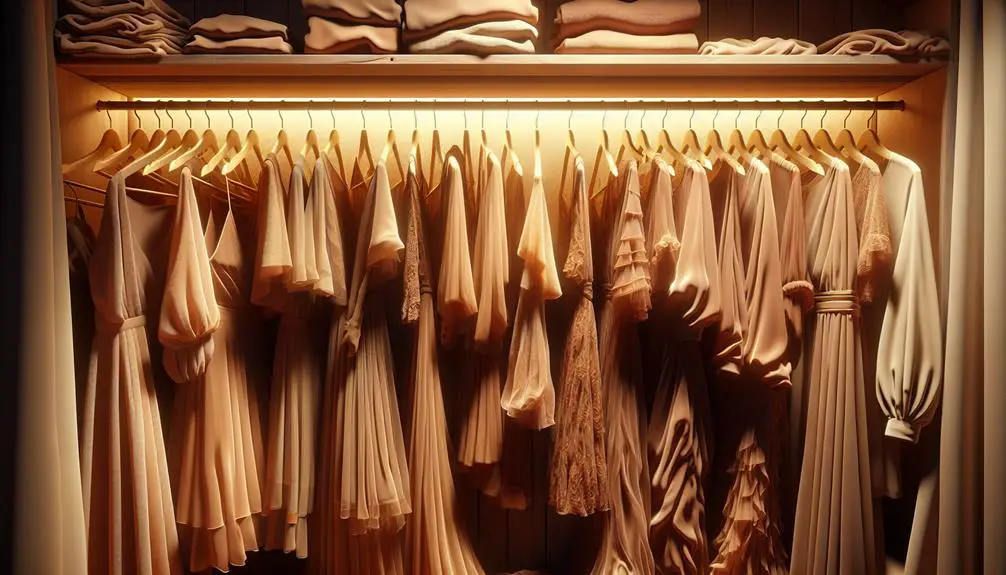In my experience, chiffon isn't really wrinkle-resistant. Whether it's made from silk or a synthetic material like polyester, chiffon tends to get wrinkles pretty easily. The fabric's lightweight and delicate nature means you have to handle it with a lot of care. If it does get wrinkled, steaming is a gentler way to smooth it out compared to ironing. You'll also want to avoid crumpling it up and store it properly to keep those pesky wrinkles at bay. There are some neat tricks and tips to manage its care better, just waiting to be discovered.
Table of Contents
Key Takeaways
- Chiffon is not highly wrinkle resistant due to its delicate and light weave.
- Silk chiffon tends to wrinkle more easily compared to synthetic polyester chiffon.
- Proper storage and handling can minimize wrinkle formation in chiffon garments.
- Gentle washing and avoiding harsh wringing helps maintain chiffon's appearance.
- Steaming chiffon can effectively remove wrinkles without direct heat contact.
Understanding Chiffon Fabric
Chiffon is a light, sheer fabric known for its airy quality and slight stretch. It's often used in evening wear and flowy dresses because it drapes so well. I've worked with chiffon on numerous projects and have come to appreciate its unique characteristics. It's made primarily from silk, but can also be found in synthetic forms like polyester.
Handling chiffon can be tricky because it's so delicate. You've got to be careful when cutting it, as it tends to slip away from you. I always make sure to use sharp scissors and work slowly to maintain control. Sewing with chiffon requires patience too. It's best to use fine needles and a lot of pins to keep everything in place.
When it comes to caring for chiffon, it's essential to be gentle. I always hand wash my chiffon garments in cold water and use a mild detergent. It's also important to avoid wringing it out, which can damage the fabric. Instead, I lay it flat to dry, away from direct sunlight to prevent fading.
Understanding these nuances is crucial if you're aiming to master working with chiffon. It's not just about handling the fabric, but also about appreciating its beauty and maintaining its quality.
Chiffon and Wrinkle Resistance
So, let's talk about how chiffon holds up against wrinkles.
We'll look at what it's made of and how you can handle any creases.
It's important to know this if you're thinking about choosing chiffon for your next outfit.
Chiffon Fabric Composition
Understanding the fabric composition of chiffon is key to exploring its resistance to wrinkles. Chiffon can be made from silk, polyester, or a blend of both. Silk chiffon is luxurious and has a slight sheen. It's inherently more supple, which can affect how it handles wrinkles. Polyester chiffon, on the other hand, is more durable and tends to resist wrinkles better due to its synthetic fibers.
The weave of chiffon also plays a role. It's typically very fine and tightly twisted, which gives it a slight puckering effect. This natural texture can help disguise minor wrinkles that might otherwise be more noticeable in a smoother fabric. So, the specific type of chiffon and its weave influence its wrinkle resistance.
Managing Chiffon Wrinkles
While we've explored what makes chiffon wrinkle-resistant, let's now look at how to manage those inevitable wrinkles when they do appear. Handling chiffon isn't tough if you know the tricks. Here's a simple guide to keep your chiffon looking smooth:
| Method | Description |
|---|---|
| Steaming | Gently steam to relax the fabric. |
| Hanging | Hang immediately after use. |
| Rolling | Roll instead of folding for storage. |
Factors Affecting Wrinkle Formation
Several factors play a key role in whether chiffon will wrinkle or not. First up, let's talk about the fabric blend. Pure silk chiffon is more prone to wrinkling compared to synthetic blends like polyester chiffon. Why? Well, silk fibers just don't bounce back like synthetics do.
Next, consider the fabric's weave. Chiffon's loose, lightweight weave makes it less resistant to creases. It's just the nature of the beast. When you've got a fabric that's airy and delicate, it's going to catch on anything and everything, which leads to wrinkles.
Humidity is another big player. In high humidity, chiffon absorbs moisture from the air. This makes it swell slightly and become more susceptible to wrinkling. Conversely, in dry conditions, the fabric remains more stable.
How you handle and store chiffon also matters. Tightly folding or squeezing chiffon can imprint creases that are tough to get out. Hanging chiffon garments is usually the way to go to avoid those pesky wrinkles.
Understanding these factors really helps in managing how chiffon behaves. If you know what affects its tendency to wrinkle, you can take steps to prevent it and keep your chiffon looking smooth and elegant.
Comparing Chiffon With Other Fabrics
Now let's see how chiffon stacks up against other popular fabrics. When it comes to comparing different types of fabrics, it's important to focus on key characteristics like wrinkle resistance, durability, and care requirements. Chiffon, known for its light and airy feel, is often juxtaposed with fabrics like cotton, polyester, and silk.
Here's a quick table to give you a clear picture:
| Fabric | Wrinkle Resistance | Durability | Ease of Care |
|---|---|---|---|
| Chiffon | Low | Medium | Delicate |
| Cotton | Medium | High | Easy |
| Polyester | High | High | Easy |
| Silk | Low | Medium | Delicate |
| Wool | Medium | High | Moderate |
From the table, you can see chiffon isn't the top when it comes to wrinkle resistance. It requires more gentle care compared to sturdier fabrics like polyester. Polyester not only resists wrinkles better but also holds up well in different conditions.
Knowing these differences helps to choose the right fabric for your needs. Chiffon, despite its lower wrinkle resistance, might still be your go-to for that elegant, flowing look, especially in formal wear. So, it's all about weighing what's more important for your specific situation.
Tips for Wrinkle-Free Chiffon
How can you keep your chiffon garments looking smooth and wrinkle-free? I've got some surefire tips that'll help you master the art of maintaining that sleek, elegant look of your chiffon without much fuss. Here's what I always do:
- Use Cold Water for Washing
- Always wash chiffon in cold water. Heat can break down the fibers and lead to wrinkles, so cold water is your best bet.
- Gentle Cycle or Hand Wash
- Stick to the gentle cycle on your washing machine or opt to hand wash your chiffon. Aggressive washing can create wrinkles that are tough to get rid of.
- Avoid Wringing Out
- Never wring out chiffon; it's a sure way to introduce wrinkles. Instead, gently squeeze out the water or let the fabric drip dry.
- Iron on Low Heat
- If you must iron chiffon, always use the lowest heat setting and place a pressing cloth between the iron and the fabric. This protects the delicate fibers from direct heat, which can cause wrinkling.
Proper Storage of Chiffon
Storing your chiffon correctly is key to keeping it smooth and ready to wear. I've found that the way you store your chiffon can really make a difference. You want to avoid any unnecessary wrinkles or damage, right? Here's a simple guide I put together to help you out:
| Method | Details |
|---|---|
| Hanging | Use padded or smooth hangers |
| Folding | Lay flat, roll gently |
| Drawer Storage | Use acid-free tissue paper |
| Long-term | Breathable garment bag |
When I hang my chiffon, I always use padded hangers. This prevents any sharp creases. If space is tight and I need to fold it, I lay the fabric flat and gently roll it up. This minimizes creases.
For drawer storage, I line the drawer with acid-free tissue. This protects the fabric from any rough surfaces or edges. If I'm storing chiffon for a long time, like my special occasion dresses, I use a breathable garment bag. It keeps moisture out but lets the fabric breathe.
Ironing and Steaming Guidelines
Now, let's talk about how to handle ironing and steaming chiffon without messing it up.
I'll show you the best ways to iron and how to steam it just right.
We'll also make sure you know how to avoid heat damage so your chiffon stays looking great.
Best Ironing Practices
What's the best way to iron chiffon without damaging it? Here's a straightforward guide to keep your chiffon looking crisp and flawless:
- Low Heat Setting: Always set your iron to the lowest heat. Chiffon can burn or melt easily.
- Pressing Cloth: Use a pressing cloth between the iron and the chiffon. This protects the fabric from direct heat.
- No Steam: Avoid using steam. Chiffon's delicate nature means too much moisture could lead to water stains.
- Gentle Pressing: Don't push down too hard. Gently press the iron over the cloth to smooth out wrinkles without stretching the fabric.
Stick to these tips, and you'll master ironing chiffon in no time!
Steaming Chiffon Correctly
While ironing chiffon requires careful heat management, steaming it offers a gentler alternative. I've found steaming to be a safer method to smooth out wrinkles without risking damage. When I steam chiffon, I make sure the steamer is held a few inches away from the fabric. This prevents any water spots and ensures that the delicate material doesn't get overwhelmed by heat.
I always keep the steamer moving in a slow, vertical motion. It's crucial not to linger too long in one spot. Quick sweeps are best. Plus, I use a steamer with an adjustable heat setting. This way, I can control the amount of steam. It's all about getting a smooth look while keeping the fabric safe.
Avoiding Heat Damage
To prevent heat damage when ironing or steaming chiffon, it's crucial to use the correct settings. Here's how I ensure my chiffon stays in perfect shape:
- Low Heat: Always set your iron or steamer to a low heat setting. Chiffon can't handle high heat.
- Use a Pressing Cloth: Place a thin cloth between the iron and the chiffon. This protects the fabric from direct contact with heat.
- No Steam: If using an iron, avoid the steam function. Chiffon responds better to dry heat.
- Gentle Pressure: Don't press down too hard. A light touch is enough to smooth out wrinkles without stressing the fabric.
Following these steps, I keep my chiffon looking great without any heat damage.
Choosing Chiffon for Your Wardrobe
Adding chiffon to your wardrobe can instantly elevate your style with its elegant and flowing appearance. I've found that when I pick chiffon pieces, I not only look more polished, but I also feel incredibly comfortable. Chiffon's lightweight nature makes it perfect for both formal and casual outfits. It's all about choosing the right pieces that fit your lifestyle and fashion sense.
Here's how I decide on chiffon items:
| Factor | Why It Matters |
|---|---|
| Color | Sets the mood; lighter shades are great for daytime, while darker hues work well for evening events. |
| Cut | Flowy cuts enhance chiffon's ethereal quality; fitted pieces add a touch of elegance. |
| Occasion | Day dresses for casual outings; blouses for work; evening gowns for formal events. |
I look for versatility in colors and cuts that can transition from day to night. It's important to have options that are adaptable to various settings. For example, a simple blush chiffon blouse can be dressed down with jeans for brunch or paired with a sleek skirt for an office setting. By focusing on these aspects, I ensure every chiffon addition enhances my wardrobe's functionality and style.
Frequently Asked Questions
Can Chiffon Be Dyed at Home Effectively?
Yes, I've successfully dyed chiffon at home using fabric-specific dyes. It's key to follow the instructions carefully and use a dye meant for synthetic fabrics to ensure vibrant, even color.
Is Chiffon Suitable for Outdoor Wedding Dresses?
I'd say chiffon's great for outdoor wedding dresses because it's light and flows beautifully. Just keep in mind, it can snag and stain easily, so you'll need to be a bit careful.
How Does Chiffon React to Humid Climates?
Chiffon doesn't handle humid climates well; it absorbs moisture and can lose shape. I've noticed it clings and doesn't breathe easily, making it less ideal for high humidity environments.
Are There Eco-Friendly Chiffon Options Available?
Yes, there are eco-friendly chiffon options available. They're made from recycled materials or organic silk, reducing environmental impact. I prefer these sustainable choices to help minimize my fashion footprint.
What Are the Historical Origins of Chiffon Fabric?
Chiffon's history starts in 1700s France, where it was first made. I've learned it's named after the French word for "cloth." It's fascinating how its delicate, sheer nature was initially silk-based.
- Is Pure Chiffon Costly? - April 23, 2024
- What Is Similar to Chiffon? - April 23, 2024
- Which Material Is Better Crepe or Chiffon? - April 23, 2024








